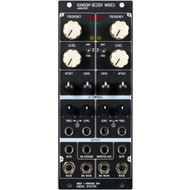ADDAC507 Random Bézier Waves - ADDAC System
by Ellison Wolf
For the first seven or so years of my modular playing (I just can't use the word "journey," I just can't) I was rigid, even though I thought myself experimental, flowy…loose. While I might have cut it up with 7/6, 5/19, or any other non-traditional rhythms, using all sorts of random-based triggering and gating, almost all of the modulation I used in my patches was synced to a main clock. This makes sense to me; I'm a punctual person, I like promptness, consistency, rock-solid history. I'm one who rolls clean socks up in their matched pairs, stacked perfectly on the left side of the top drawer of my dresser. But I also like modulation, and for the longest time, I couldn't take randomness that was out of sync. Eventually, I overcame my predilection and now heartily embrace random modulation. And it's a good thing…
ADDAC System's 507 Random Bézier Waves is a collaboration between the Portuguese company and Monotrail (AKA Rijnder Kamerbeek, a Dutch artist based in Berlin), and features two channels—A and B—of, yup, you guessed it, random bipolar CV generation of the smooth kind. Each channel is very nearly a mirror image of the other, as well as independent of the other, with just a few controls overall to tweak to your liking. In some ways, it seems a bit of an oxymoron to have controls over something that's supposed to be random, but modular is all about control, so what's one to do…but join in!
The two main controls are Frequency, which sets the interval time between the random stepping, and Level, which is kind of like a VCA that adjusts the output amount of modulation. Level has a three-position mini toggle (Limit, Thru, Fold) next to it that acts like the threshold of a compressor, determining the behavior of the signal when it passes that threshold. This is a pretty neat and unique feature which offers yet another chance for variation. The Offset control moves the entirety of the modulation range, enabling you to home in on the best parts, and the Curve control is where the shape of the interpolation of the voltage changes is controlled. In Eurorack, we're used to going from linear to exponential, or vice versa, but Bézier curves, popular in computer graphics, are a different breed and look somewhat like tweaked sine and triangle waves; my two favorite shapes for modulation use. Rounding out the controls are bi-polar CV inputs with attenuverters for the Frequency and Level for each section. These CV inputs are normalled to the output of the opposite channel (broken by patching into the inputs), so while each channel is independent of the other, each channel can still affect the other, and this can make for some extra chaotic modulation; there are jumpers on the back to turn this feature off if you wish. Colored LEDs near the Frequency control show the polarity and strength of the modulation for each channel (red for positive and green for negative), and a yellow LED to show when there's a gate output.
Speaking of outputs…there are three per channel: Gate, Wave, and Inverse Wave, and a center two-output section—AB Average and Inverted Average. The only difference between the two sides is that Channel A's gate output is steady and tied to its frequency setting, triggering with each new voltage change. Channel B's gate output, on the other hand, only outputs when the main output is positive, which is more of a random trigger, so you've kind of got the best of both worlds. Random and consistent!
With six different modulation outputs, there's a lot of opportunity to add some randomness all over a patch; and with the two Gate outputs, it's easy to sync/not sync things up to this randomness, and you can even use the Gate outs as a clock to control a drum module or something with a constant beat, to anchor the patch to 507, as there's no way to clock it from an outside source, which, of course, would defeat the random aspect, right?!
Using one channel to slowly open/close a VCA produces a random and dynamic drone, though I wish there was some way to make the wave unipolar so you don't lose sound when the voltage drops below zero. Oh wait, there is! By using the offset, you can dial in positive-only voltages. Using the other channel for some random pitching of a VCO and adding the inverse output patched into a filter cutoff to effect change, I was able to get some great sci-fi alien type generative stuff when the modulation pace was slow.
507 is more hands-on than the average modulation source, and it's fun to do some self-patching experimentation, as well as change the Limit/Fold/Thru toggle to hear the differences. Using some external LFOs to modulate the Frequency and Level added another level of complexity, though when you're talking about random, it's all complex and simple at the same time.
I found that 507 worked really well as a set-and-forget modulation source (and trigger source). Slowly evolving timbre changes, random drum triggers…anything you want random modulation for, 507 fit the bill, and I found the onboard attenuators to be really handy—it just makes everything that much easier and more streamlined.
ADDAC System always manages to bring something new to my rack, in this case Bézier curves—something I'd only messed with in graphics programs—and "control" over random elements in a patch. These might seem like small details, but isn't that where the distinctions and beauty of modular lie? I'd say most definitely.
Price: $349


